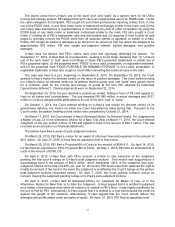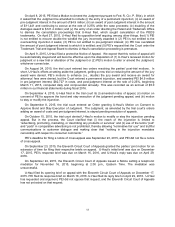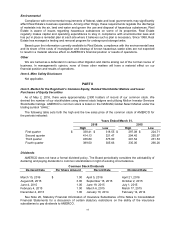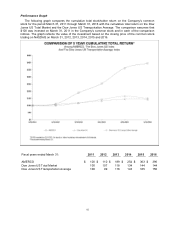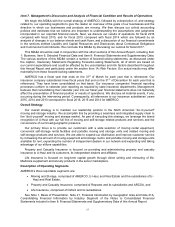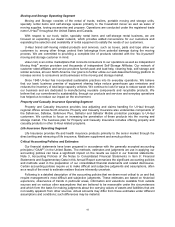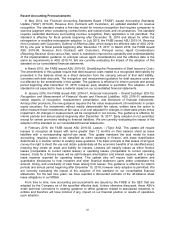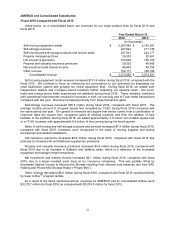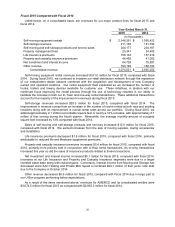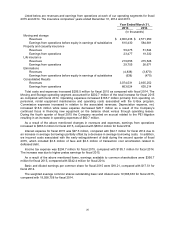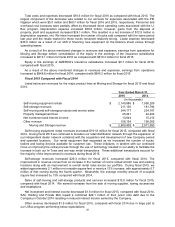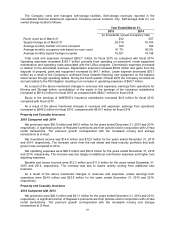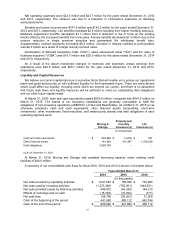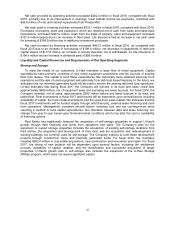U-Haul 2016 Annual Report Download - page 28
Download and view the complete annual report
Please find page 28 of the 2016 U-Haul annual report below. You can navigate through the pages in the report by either clicking on the pages listed below, or by using the keyword search tool below to find specific information within the annual report.22
Recent Accounting Pronouncements
In May 2014, the Financial Accounting Standards Board (“FASB”) issued Accounting Standards
Update (“ASU”) 2014-09, Revenue from Contracts with Customers, an updated standard on revenue
recognition. The standard creates a five-step model for revenue recognition that requires companies to
exercise judgment when considering contract terms and relevant facts and circumstances. The standard
requires expanded disclosure surrounding revenue recognition. Early application is not permitted. The
standard is effective for fiscal periods beginning after December 15, 2016 and allows for either full
retrospective or modified retrospective adoption. In July 2015, the FASB issued ASU 2015-14, Revenue
from Contracts with Customers, Deferral of Effective Date, which delays the effective date of ASU 2014-
09 by one year to fiscal periods beginning after December 15, 2017. In March 2016, the FASB issued
ASU 2016-08, Revenue from Contracts with Customers, Principal versus Agent Considerations
(Reporting Revenue Gross versus Net), which is intended to improve the operability and understandability
of the implementation guidance on principal versus agent considerations and the effective date is the
same as requirements in ASU 2015-14. We are currently evaluating the impact of the adoption of this
standard on our consolidated financial statements.
In March 2015, the FASB issued ASU 2015-03, Simplifying the Presentation of Debt Issuance Costs.
The amendments in this update require that debt issuance costs related to a recognized debt liability be
presented in the balance sheet as a direct deduction from the carrying amount of that debt liability,
consistent with debt discounts. The recognition and measurement guidance for debt issuance costs are
not affected by the amendments in this update. The guidance is effective for interim periods and annual
period beginning after December 15, 2015; however early adoption is permitted. The adoption of this
standard is not expected to have a material impact on our consolidated financial statements.
In January 2016, the FASB issued ASU 2016-01, Financial Instruments – Overall (subtopic 825-10):
Recognition and Measurement of Financial Assets and Financial Liabilities. ASU 2016-01 addresses
certain aspects of recognition, measurement, presentation, and disclosure of financial instruments.
Among other provisions, the new guidance requires the fair value measurement of investments in certain
equity securities. For investments without readily determinable fair values, entities have the option to
either measure these investments at fair value or at cost adjusted for changes in observable prices minus
impairment. All changes in measurement will be recognized in net income. The guidance is effective for
interim periods and annual period beginning after December 15, 2017. Early adoption is not permitted,
except for certain provisions relating to financial liabilities. We are currently evaluating the impact of the
adoption of this standard on our consolidated financial statements.
In February 2016, the FASB issued ASU 2016-02, Leases - (Topic 842). This update will require
lessees to recognize all leases with terms greater than 12 months on their balance sheet as lease
liabilities with a corresponding right-of-use asset. This update maintains the dual model for lease
accounting, requiring leases to be classified as either operating or finance, with lease classification
determined in a manner similar to existing lease guidance. The basic principle is that leases of all types
convey the right to direct the use and obtain substantially all the economic benefits of an identified asset,
meaning they create an asset and liability for lessees. Lessees will classify leases as either finance
leases (comparable to current capital leases) or operating leases (comparable to current operating
leases). Costs for a finance lease will be split between amortization and interest expense, with a single
lease expense reported for operating leases. This update also will require both qualitative and
quantitative disclosures to help investors and other financial statement users better understand the
amount, timing, and uncertainty of cash flows arising from leases. The guidance is effective for interim
periods and annual period beginning after December 15, 2018; however early adoption is permitted. We
are currently evaluating the impact of the adoption of this standard on our consolidated financial
statements. For the last nine years, we have reported a discounted estimate of the off-balance sheet
lease obligations in our MD&A.
From time to time, new accounting pronouncements are issued by the FASB or the SEC that are
adopted by the Company as of the specified effective date. Unless otherwise discussed, these ASU’s
entail technical corrections to existing guidance or affect guidance related to specialized industries or
entities and therefore will have minimal, if any, impact on our financial position or results of operations
upon adoption.


